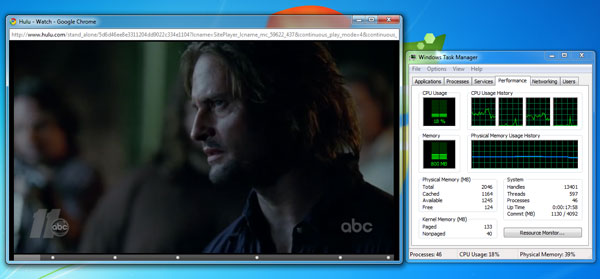Zotac ZBOX HD-ID11 Review: Next Gen ION is Better & Worse than ION1
by Anand Lal Shimpi on May 6, 2010 3:51 PM EST- Posted in
- GPUs
- Next Generation ION
- HD-ID11
- ZOTAC
- NVIDIA
Flash 10.1 Acceleration: The Problem
Not only does gaming performance sometimes fall behind the original ION, but there’s an issue with GPU accelerated Flash playback. The current NVIDIA driver requires the decoded video data to be copied back and forth between system memory and the GPU frame buffer. Unfortunately at 1080p there’s not enough bandwidth over a single PCIe x1 lane to do that, and thus you get a lot of stuttering. Even 480p content won't play smoothly if you scale it up to too large of a window. GPU acceleration works for standard 480p videos, I measured anywhere from 15 - 25% CPU utilization while watching an episode of Lost on Hulu.

NVIDIA plans to release an updated driver in June that fixes the problem by executing more of the Flash loop on the GPU itself, thus avoiding that costly trip to system memory.
This is a big enough problem today where if you plan on watching any Flash videos in anything other than a 480p window (or slightly larger), I'd hold off on a NG-ION purchase.










40 Comments
View All Comments
rnjeezy - Thursday, May 6, 2010 - link
and switch wifi to usbTekkamanraiden - Thursday, May 6, 2010 - link
While this looks pretty kick ass I'm looking forward to the Amd version. I'm curious how well the Neo processor with 3200 will do against the Aton with Ion2.Soulkeeper - Friday, May 7, 2010 - link
I too would like to see products from amd and/or via to compete here.I'm tired of "the intel show" 24/7
I wouldn't pay $100 for that ion thing
dealcorn - Friday, May 7, 2010 - link
As the Zotac NM10-B-E motherboard is shipping with HDMI and the Intel NM10 chipset, the Broadcom Crystal media solution is a viable build your own HTPC strategy that operates on fewer watts. I would have liked a side by side comparison.nick.cardwell - Friday, May 7, 2010 - link
Does this or any ION2 nettop use Optimus??? I am looking for a small D510 system to run headless and would be willing to buy an ION2 system strictly for the resale value if it uses Optimus to switch off that power hungry GPU. I am sill waiting on the Shuttle XS35 to show up as it is fanless.CZroe - Friday, May 7, 2010 - link
The comments in the article about manufacturers not wanting to reclaim PCIe lanes from WiFi and GbE don't sound so convincing. For example, they could easily integrate WiFi via internal USB or an Ethernet bridge.Heck, if nVidia wanted to make a real symbiotic chipset to go with this they could actually engineer a GbE/WiFi chip that uses multiple internal USB ports to achieve enough bandwidth. And by "enough" I mean "somewhat more than 100mbps but less than 1,000mbps." Users can't often maximize GbE because they need a GbE switch for full duplex and, assuming a max-speed file copy, a destination drive which can write as fast as the source can send. I doubt many users really need GbE over 10/100 Fast Ethernet/802.11n.
Also, what happened to all the rumors of an OC'd PCIe bus for ION2?
As for Zotac's design, I'd much prefer a larger, cooler, quieter design than this, especially if it is going in a home theater. If it would still be super-small, why not give it a proportionally huge HSF? The LEAST they could do is give it metallic housing and throw a heat pipe on it (even just one side).
rennya - Friday, May 7, 2010 - link
The latency guys, the latency.KaarlisK - Sunday, May 9, 2010 - link
Besides which, the NM10 chipset only has 1 USB2 controller, so no increase in bandwidth from ganging USB ports.modemide - Friday, May 7, 2010 - link
I enjoyed the article and this looks like a viable option for my next HTPC. However, I didn't see anything addressing the signal issues most people experienced with the initial version. Can you comment on that?Thanks.
Bateluer - Friday, May 7, 2010 - link
How come we don't see any of the ULV CPUs in form factors like this? I cannot imagine it'd be too difficult to stick in a Celeron SU2300, or a Pentium SU4100, or one of the ULV C2S chips. There's super netbooks that are thinner than these nettops that use these ULV chips. I can't imagine that designing a little beefier cooling system in the same Zotac chassis or into the Acer Revo chassis would be overly difficult. It may add a little to the price, but the trade off in performance might be worth it.